Paper Menu >>
Journal Menu >>
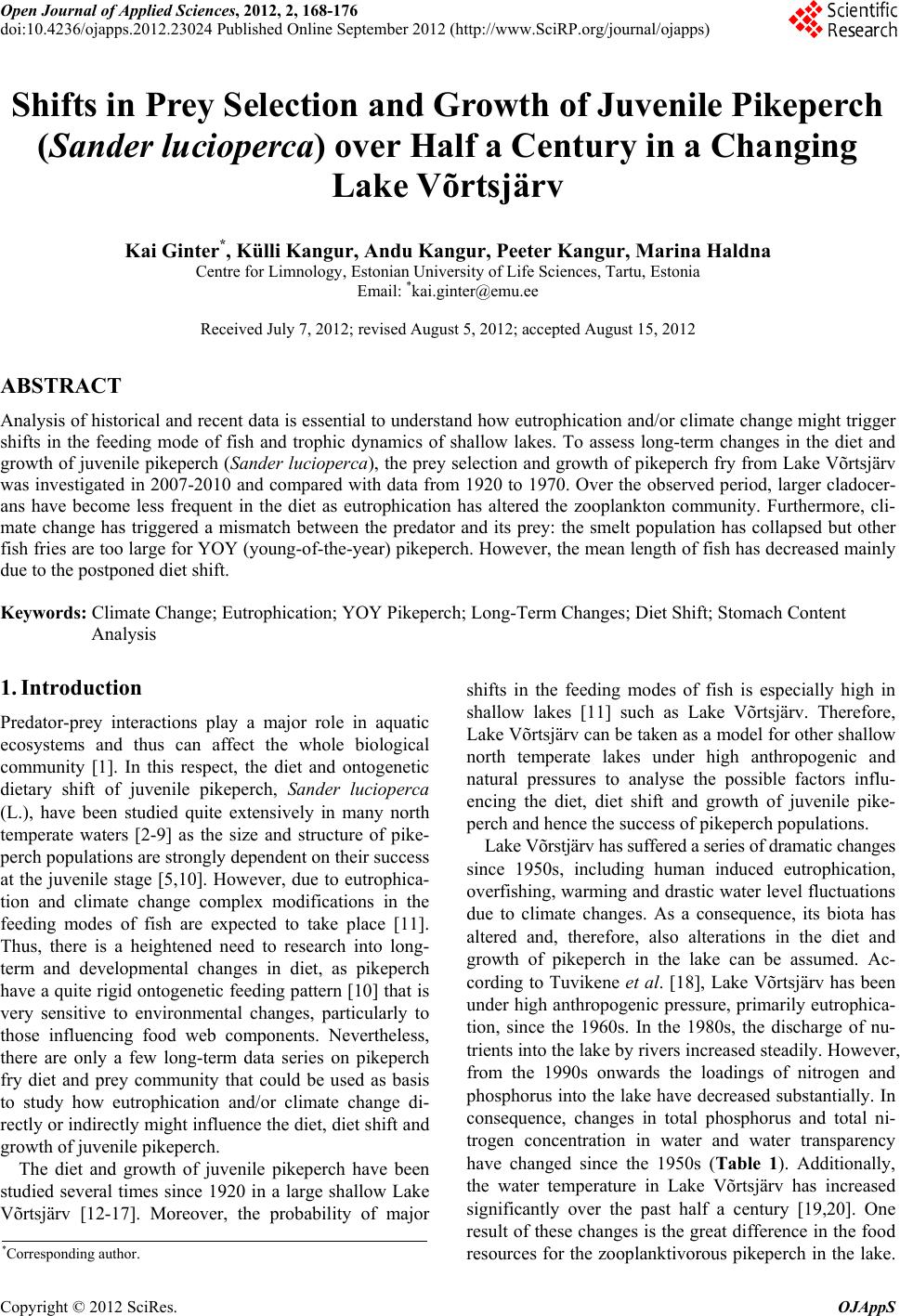 Open Journal of Applied Sciences, 2012, 2, 168-176 doi:10.4236/ojapps.2012.23024 Published Online September 2012 (http://www.SciRP.org/journal/ojapps) Shifts in Prey Selection and Growth of Juvenile Pikeperch (Sander lucioperca) over Half a Century in a Changing Lake Võrtsjärv Kai Ginter*, Külli Kangur, Andu Kangur, Peeter Kangur, Marina Haldna Centre for Limnology, Estonian University of Life Sciences, Tartu, Estonia Email: *kai.ginter@emu.ee Received July 7, 2012; revised August 5, 2012; accepted August 15, 2012 ABSTRACT Analysis of historical and recent data is essential to understand how eutrophication and/or climate change might trigger shifts in the feeding mode of fish and trophic dynamics of shallow lakes. To assess long-term changes in the diet and growth of juvenile pikeperch (Sander lucioperca), the prey selection and growth of pikeperch fry from Lake Võrtsjärv was investigated in 2007-2010 and compared with data from 1920 to 1970. Over the observed period, larger cladocer- ans have become less frequent in the diet as eutrophication has altered the zooplankton community. Furthermore, cli- mate change has triggered a mismatch between the predator and its prey: the smelt population has collapsed but other fish fries are too large for YOY (young-of-the-year) pikeperch. However, the mean length of fish has decreased mainly due to the postponed diet shift. Keywords: Climate Change; Eutrophication; YOY Pikeperch; Long-Term Changes; Diet Shift; Stomach Content Analysis 1. Introduction Predator-prey interactions play a major role in aquatic ecosystems and thus can affect the whole biological community [1]. In this respect, the diet and ontogenetic dietary shift of juvenile pikeperch, Sander lucioperca (L.), have been studied quite extensively in many north temperate waters [2-9] as the size and structure of pike- perch populations are strongly dependent on their success at the juvenile stage [5,10]. However, due to eutrophica- tion and climate change complex modifications in the feeding modes of fish are expected to take place [11]. Thus, there is a heightened need to research into long- term and developmental changes in diet, as pikeperch have a quite rigid ontogenetic feeding pattern [10] that is very sensitive to environmental changes, particularly to those influencing food web components. Nevertheless, there are only a few long-term data series on pikeperch fry diet and prey community that could be used as basis to study how eutrophication and/or climate change di- rectly or indirectly might influence the diet, diet shift and growth of juvenile pikeperch. The diet and growth of juvenile pikeperch have been studied several times since 1920 in a large shallow Lake Võrtsjärv [12-17]. Moreover, the probability of major shifts in the feeding modes of fish is especially high in shallow lakes [11] such as Lake Võrtsjärv. Therefore, Lake Võrtsjärv can be taken as a model for other shallow north temperate lakes under high anthropogenic and natural pressures to analyse the possible factors influ- encing the diet, diet shift and growth of juvenile pike- perch and hence the success of pikeperch populations. Lake Võrstjärv has suffered a series of dramatic changes since 1950s, including human induced eutrophication, overfishing, warming and drastic water level fluctuations due to climate changes. As a consequence, its biota has altered and, therefore, also alterations in the diet and growth of pikeperch in the lake can be assumed. Ac- cording to Tuvikene et al. [18], Lake Võrtsjärv has been under high anthropogenic pressure, primarily eutrophica- tion, since the 1960s. In the 1980s, the discharge of nu- trients into the lake by rivers increased steadily. However, from the 1990s onwards the loadings of nitrogen and phosphorus into the lake have decreased substantially. In consequence, changes in total phosphorus and total ni- trogen concentration in water and water transparency have changed since the 1950s (Table 1). Additionally, the water temperature in Lake Võrtsjärv has increased significantly over the past half a century [19,20]. One result of these changes is the great difference in the food resources for the zooplanktivorous pikeperch in the lake. *Corresponding author. Copyright © 2012 SciRes. OJAppS 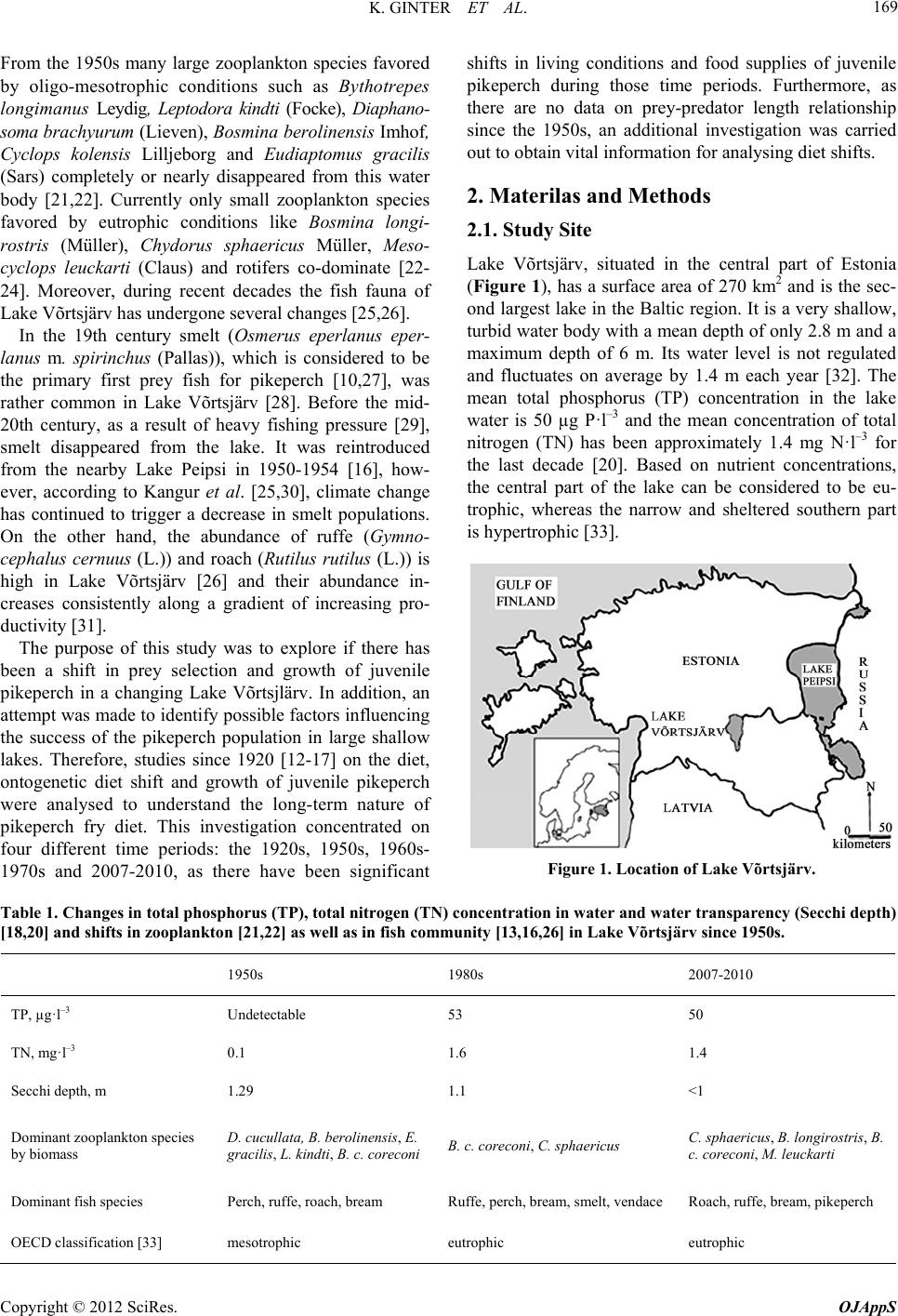 K. GINTER ET AL. 169 From the 1950s many large zooplankton species favored by oligo-mesotrophic conditions such as Bythotrepes longimanus Leydig, Leptodora kindti (Focke), Diaphano- soma brachyurum (Lieven), Bosmina berolinensis Imhof, Cyclops kolensis Lilljeborg and Eudiaptomus gracilis (Sars) completely or nearly disappeared from this water body [21,22]. Currently only small zooplankton species favored by eutrophic conditions like Bosmina longi- rostris (Müller), Chydorus sphaericus Müller, Meso- cyclops leuckarti (Claus) and rotifers co-dominate [22- 24]. Moreover, during recent decades the fish fauna of Lake Võrtsjärv has undergone several changes [25,26]. In the 19th century smelt (Osmerus eperlanus eper- lanus m. spirinchus (Pallas)), which is considered to be the primary first prey fish for pikeperch [10,27], was rather common in Lake Võrtsjärv [28]. Before the mid- 20th century, as a result of heavy fishing pressure [29], smelt disappeared from the lake. It was reintroduced from the nearby Lake Peipsi in 1950-1954 [16], how- ever, according to Kangur et al. [25,30], climate change has continued to trigger a decrease in smelt populations. On the other hand, the abundance of ruffe (Gymno- cephalus cernuus (L.)) and roach (Rutilus rutilus (L.)) is high in Lake Võrtsjärv [26] and their abundance in- creases consistently along a gradient of increasing pro- ductivity [31]. The purpose of this study was to explore if there has been a shift in prey selection and growth of juvenile pikeperch in a changing Lake Võrtsjlärv. In addition, an attempt was made to identify possible factors influencing the success of the pikeperch population in large shallow lakes. Therefore, studies since 1920 [12-17] on the diet, ontogenetic diet shift and growth of juvenile pikeperch were analysed to understand the long-term nature of pikeperch fry diet. This investigation concentrated on four different time periods: the 1920s, 1950s, 1960s- 1970s and 2007-2010, as there have been significant shifts in living conditions and food supplies of juvenile pikeperch during those time periods. Furthermore, as there are no data on prey-predator length relationship since the 1950s, an additional investigation was carried out to obtain vital information for analysing diet shifts. 2. Materilas and Methods 2.1. Study Site Lake Võrtsjärv, situated in the central part of Estonia (Figure 1), has a surface area of 270 km2 and is the sec- ond largest lake in the Baltic region. It is a very shallow, turbid water body with a mean depth of only 2.8 m and a maximum depth of 6 m. Its water level is not regulated and fluctuates on average by 1.4 m each year [32]. The mean total phosphorus (TP) concentration in the lake water is 50 µg P·l–3 and the mean concentration of total nitrogen (TN) has been approximately 1.4 mg N·l–3 for the last decade [20]. Based on nutrient concentrations, the central part of the lake can be considered to be eu- trophic, whereas the narrow and sheltered southern part is hypertrophic [33]. Figure 1. Location of Lake Võrtsjärv. Table 1. Changes in total phosphorus (TP), total nitrogen (TN) concentration in water and water transparency (Secchi depth) [18,20] and shifts in zooplankton [21,22] as well as in fish community [13,16,26] in Lake Võrtsjärv since 1950s. 1950s 1980s 2007-2010 TP, µg·l–3 Undetectable 53 50 TN, mg·l–3 0.1 1.6 1.4 Secchi depth, m 1.29 1.1 <1 Dominant zooplankton species by biomass D. cucullata, B. berolinensis, E. gracilis, L. kindti, B. c. coreconi B. c. coreconi, C. sphaericus C. sphaericus, B. longirostris, B. c. coreconi, M. leuckarti Dominant fish species Perch, ruffe, roach, bream Ruffe, perch, bream, smelt, vendace Roach, ruffe, bream, pikeperch OECD classification [33] mesotrophic eutrophic eutrophic Copyright © 2012 SciRes. OJAppS 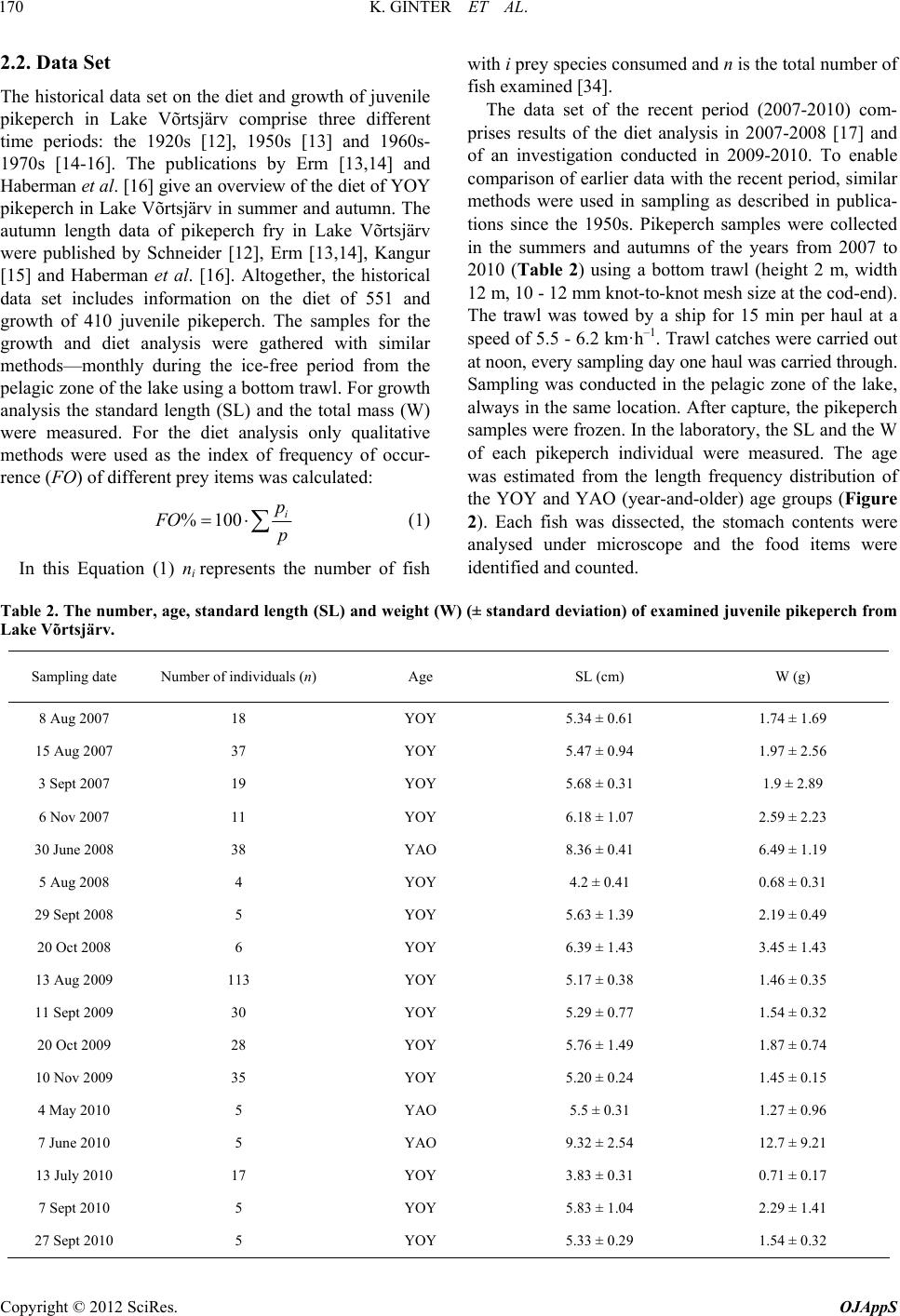 K. GINTER ET AL. 170 2.2. Data Set The historical data set on the diet and growth of juvenile pikeperch in Lake Võrtsjärv comprise three different time periods: the 1920s [12], 1950s [13] and 1960s- 1970s [14-16]. The publications by Erm [13,14] and Haberman et al. [16] give an overview of the diet of YOY pikeperch in Lake Võrtsjärv in summer and autumn. The autumn length data of pikeperch fry in Lake Võrtsjärv were published by Schneider [12], Erm [13,14], Kangur [15] and Haberman et al. [16]. Altogether, the historical data set includes information on the diet of 551 and growth of 410 juvenile pikeperch. The samples for the growth and diet analysis were gathered with similar methods—monthly during the ice-free period from the pelagic zone of the lake using a bottom trawl. For growth analysis the standard length (SL) and the total mass (W) were measured. For the diet analysis only qualitative methods were used as the index of frequency of occur- rence (FO) of different prey items was calculated: %100 i p FO p (1) In this Equation (1) ni represents the number of fish with i prey species consumed and n is the total number of fish examined [34]. The data set of the recent period (2007-2010) com- prises results of the diet analysis in 2007-2008 [17] and of an investigation conducted in 2009-2010. To enable comparison of earlier data with the recent period, similar methods were used in sampling as described in publica- tions since the 1950s. Pikeperch samples were collected in the summers and autumns of the years from 2007 to 2010 (Table 2) using a bottom trawl (height 2 m, width 12 m, 10 - 12 mm knot-to-knot mesh size at the cod-end). The trawl was towed by a ship for 15 min per haul at a speed of 5.5 - 6.2 km·h–1. Trawl catches were carried out at noon, every sampling day one haul was carried through. Sampling was conducted in the pelagic zone of the lake, always in the same location. After capture, the pikeperch samples were frozen. In the laboratory, the SL and the W of each pikeperch individual were measured. The age was estimated from the length frequency distribution of the YOY and YAO (year-and-older) age groups (Figure 2). Each fish was dissected, the stomach contents were analysed under microscope and the food items were identified and counted. Table 2. The number, age, standard length (S L) and weight (W) (± standard deviation) of examined juvenile pikepe rch from Lake Võrtsjärv. Sampling date Number of individuals (n) Age SL (cm) W (g) 8 Aug 2007 18 YOY 5.34 ± 0.61 1.74 ± 1.69 15 Aug 2007 37 YOY 5.47 ± 0.94 1.97 ± 2.56 3 Sept 2007 19 YOY 5.68 ± 0.31 1.9 ± 2.89 6 Nov 2007 11 YOY 6.18 ± 1.07 2.59 ± 2.23 30 June 2008 38 YAO 8.36 ± 0.41 6.49 ± 1.19 5 Aug 2008 4 YOY 4.2 ± 0.41 0.68 ± 0.31 29 Sept 2008 5 YOY 5.63 ± 1.39 2.19 ± 0.49 20 Oct 2008 6 YOY 6.39 ± 1.43 3.45 ± 1.43 13 Aug 2009 113 YOY 5.17 ± 0.38 1.46 ± 0.35 11 Sept 2009 30 YOY 5.29 ± 0.77 1.54 ± 0.32 20 Oct 2009 28 YOY 5.76 ± 1.49 1.87 ± 0.74 10 Nov 2009 35 YOY 5.20 ± 0.24 1.45 ± 0.15 4 May 2010 5 YAO 5.5 ± 0.31 1.27 ± 0.96 7 June 2010 5 YAO 9.32 ± 2.54 12.7 ± 9.21 13 July 2010 17 YOY 3.83 ± 0.31 0.71 ± 0.17 7 Sept 2010 5 YOY 5.83 ± 1.04 2.29 ± 1.41 27 Sept 2010 5 YOY 5.33 ± 0.29 1.54 ± 0.32 Copyright © 2012 SciRes. OJAppS 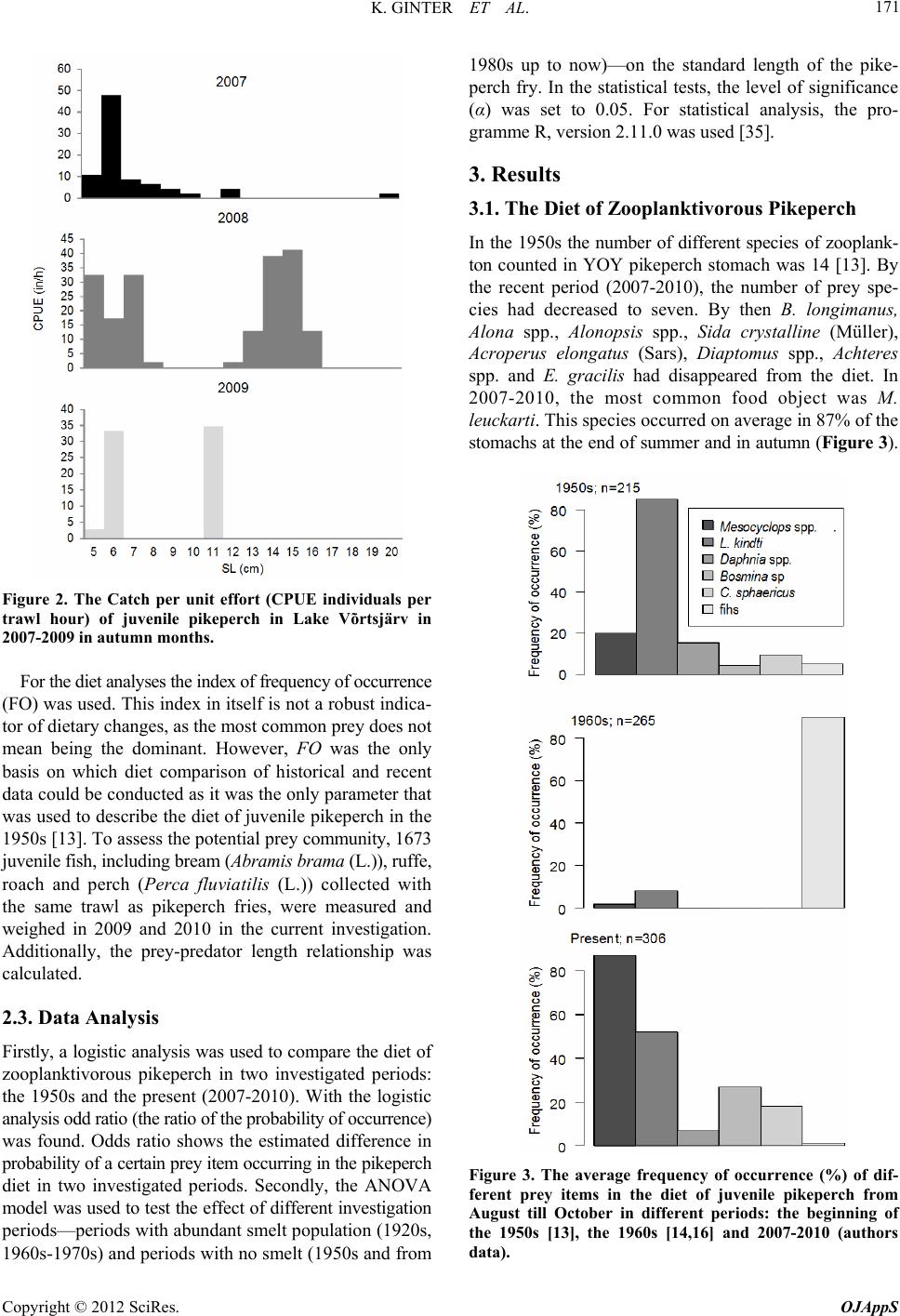 K. GINTER ET AL. 171 Figure 2. The Catch per unit effort (CPUE individuals per trawl hour) of juvenile pikeperch in Lake Võrtsjärv in 2007-2009 in autumn months. For the diet analyses the index of frequency of occurrence (FO) was used. This index in itself is not a robust indica- tor of dietary changes, as the most common prey does not mean being the dominant. However, FO was the only basis on which diet comparison of historical and recent data could be conducted as it was the only parameter that was used to describe the diet of juvenile pikeperch in the 1950s [13]. To assess the potential prey community, 1673 juvenile fish, including bream (Abramis brama (L.)), ruffe, roach and perch (Perca fluviatilis (L.)) collected with the same trawl as pikeperch fries, were measured and weighed in 2009 and 2010 in the current investigation. Additionally, the prey-predator length relationship was calculated. 2.3. Data Analysis Firstly, a logistic analysis was used to compare the diet of zooplanktivorous pikeperch in two investigated periods: the 1950s and the present (2007-2010). With the logistic analysis odd ratio (the ratio of the probability of occurrence) was found. Odds ratio shows the estimated difference in probability of a certain prey item occurring in the pikeperch diet in two investigated periods. Secondly, the ANOVA model was used to test the effect of different investigation periods—periods with abundant smelt population (1920s, 1960s-1970s) and periods with no smelt (1950s and from 1980s up to now)—on the standard length of the pike- perch fry. In the statistical tests, the level of significance (α) was set to 0.05. For statistical analysis, the pro- gramme R, version 2.11.0 was used [35]. 3. Results 3.1. The Diet of Zooplanktivorous Pikeperch In the 1950s the number of different species of zooplank- ton counted in YOY pikeperch stomach was 14 [13]. By the recent period (2007-2010), the number of prey spe- cies had decreased to seven. By then B. longimanus, Alona spp., Alonopsis spp., Sida crystalline (Müller), Acroperus elongatus (Sars), Diaptomus spp., Achteres spp. and E. gracilis had disappeared from the diet. In 2007-2010, the most common food object was M. leuckarti. This species occurred on average in 87% of the stomachs at the end of summer and in autumn (Figure 3). Figure 3. The average frequency of occurrence (%) of dif- ferent prey items in the diet of juvenile pikeperch from August till October in different periods: the beginning of the 1950s [13], the 1960s [14,16] and 2007-2010 (authors data). Copyright © 2012 SciRes. OJAppS 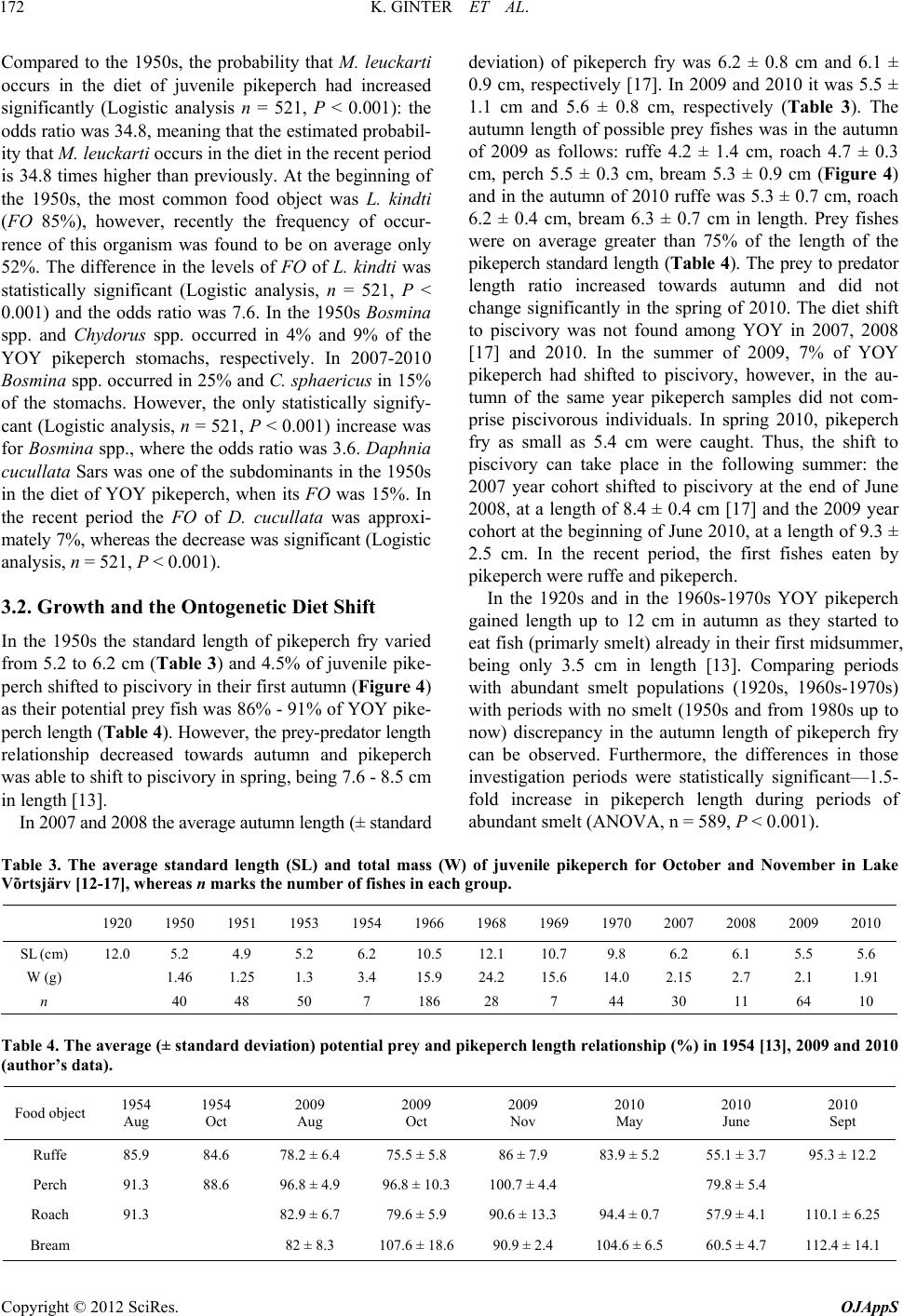 K. GINTER ET AL. 172 Compared to the 1950s, the probability that M. leuckarti occurs in the diet of juvenile pikeperch had increased significantly (Logistic analysis n = 521, P < 0.001): the odds ratio was 34.8, meaning that the estimated probabil- ity that M. leuckarti occurs in the diet in the recent period is 34.8 times higher than previously. At the beginning of the 1950s, the most common food object was L. kindti (FO 85%), however, recently the frequency of occur- rence of this organism was found to be on average only 52%. The difference in the levels of FO of L. kindti was statistically significant (Logistic analysis, n = 521, P < 0.001) and the odds ratio was 7.6. In the 1950s Bosmina spp. and Chydorus spp. occurred in 4% and 9% of the YOY pikeperch stomachs, respectively. In 2007-2010 Bosmina spp. occurred in 25% and C. sphaericus in 15% of the stomachs. However, the only statistically signify- cant (Logistic analysis, n = 521, P < 0.001) increase was for Bosmina spp., where the odds ratio was 3.6. Daphnia cucullata Sars was one of the subdominants in the 1950s in the diet of YOY pikeperch, when its FO was 15%. In the recent period the FO of D. cucullata was approxi- mately 7%, whereas the decrease was significant (Logistic analysis, n = 521, P < 0.001). 3.2. Growth and the Ontogenetic Diet Shift In the 1950s the standard length of pikeperch fry varied from 5.2 to 6.2 cm (Table 3) and 4.5% of juvenile pike- perch shifted to piscivory in their first autumn (Figure 4) as their potential prey fish was 86% - 91% of YOY pike- perch length (Table 4). However, the prey-predator length relationship decreased towards autumn and pikeperch was able to shift to piscivory in spring, being 7.6 - 8.5 cm in length [13]. In 2007 and 2008 the average autumn length (± standard deviation) of pikeperch fry was 6.2 ± 0.8 cm and 6.1 ± 0.9 cm, respectively [17]. In 2009 and 2010 it was 5.5 ± 1.1 cm and 5.6 ± 0.8 cm, respectively (Table 3). The autumn length of possible prey fishes was in the autumn of 2009 as follows: ruffe 4.2 ± 1.4 cm, roach 4.7 ± 0.3 cm, perch 5.5 ± 0.3 cm, bream 5.3 ± 0.9 cm (Figure 4) and in the autumn of 2010 ruffe was 5.3 ± 0.7 cm, roach 6.2 ± 0.4 cm, bream 6.3 ± 0.7 cm in length. Prey fishes were on average greater than 75% of the length of the pikeperch standard length (Table 4). The prey to predator length ratio increased towards autumn and did not change significantly in the spring of 2010. The diet shift to piscivory was not found among YOY in 2007, 2008 [17] and 2010. In the summer of 2009, 7% of YOY pikeperch had shifted to piscivory, however, in the au- tumn of the same year pikeperch samples did not com- prise piscivorous individuals. In spring 2010, pikeperch fry as small as 5.4 cm were caught. Thus, the shift to piscivory can take place in the following summer: the 2007 year cohort shifted to piscivory at the end of June 2008, at a length of 8.4 ± 0.4 cm [17] and the 2009 year cohort at the beginning of June 2010, at a length of 9.3 ± 2.5 cm. In the recent period, the first fishes eaten by pikeperch were ruffe and pikeperch. In the 1920s and in the 1960s-1970s YOY pikeperch gained length up to 12 cm in autumn as they started to eat fish (primarly smelt) already in their first midsummer, being only 3.5 cm in length [13]. Comparing periods with abundant smelt populations (1920s, 1960s-1970s) with periods with no smelt (1950s and from 1980s up to now) discrepancy in the autumn length of pikeperch fry can be observed. Furthermore, the differences in those investigation periods were statistically significant—1.5- fold increase in pikeperch length during periods of abundant smelt (ANOVA, n = 589, P < 0.001). Table 3. The average standard length (SL) and total mass (W) of juvenile pikeperch for October and November in Lake Võrtsjärv [12-17], whereas n marks the number of fishes in each group. 1920 1950 1951 1953 1954 1966 1968 1969 1970 2007 2008 2009 2010 SL (cm) 12.0 5.2 4.9 5.2 6.2 10.5 12.1 10.7 9.8 6.2 6.1 5.5 5.6 W (g) 1.46 1.25 1.3 3.4 15.9 24.2 15.6 14.0 2.15 2.7 2.1 1.91 n 40 48 50 7 186 28 7 44 30 11 64 10 Table 4. The average (± standard deviation) potential prey and pikeperch length relationship (%) in 1954 [13], 2009 and 2010 (author’s data). Food object 1954 Aug 1954 Oct 2009 Aug 2009 Oct 2009 Nov 2010 May 2010 June 2010 Sept Ruffe 85.9 84.6 78.2 ± 6.4 75.5 ± 5.8 86 ± 7.9 83.9 ± 5.2 55.1 ± 3.7 95.3 ± 12.2 Perch 91.3 88.6 96.8 ± 4.9 96.8 ± 10.3 100.7 ± 4.4 79.8 ± 5.4 Roach 91.3 82.9 ± 6.7 79.6 ± 5.9 90.6 ± 13.3 94.4 ± 0.7 57.9 ± 4.1 110.1 ± 6.25 Bream 82 ± 8.3 107.6 ± 18.6 90.9 ± 2.4 104.6 ± 6.5 60.5 ± 4.7 112.4 ± 14.1 Copyright © 2012 SciRes. OJAppS 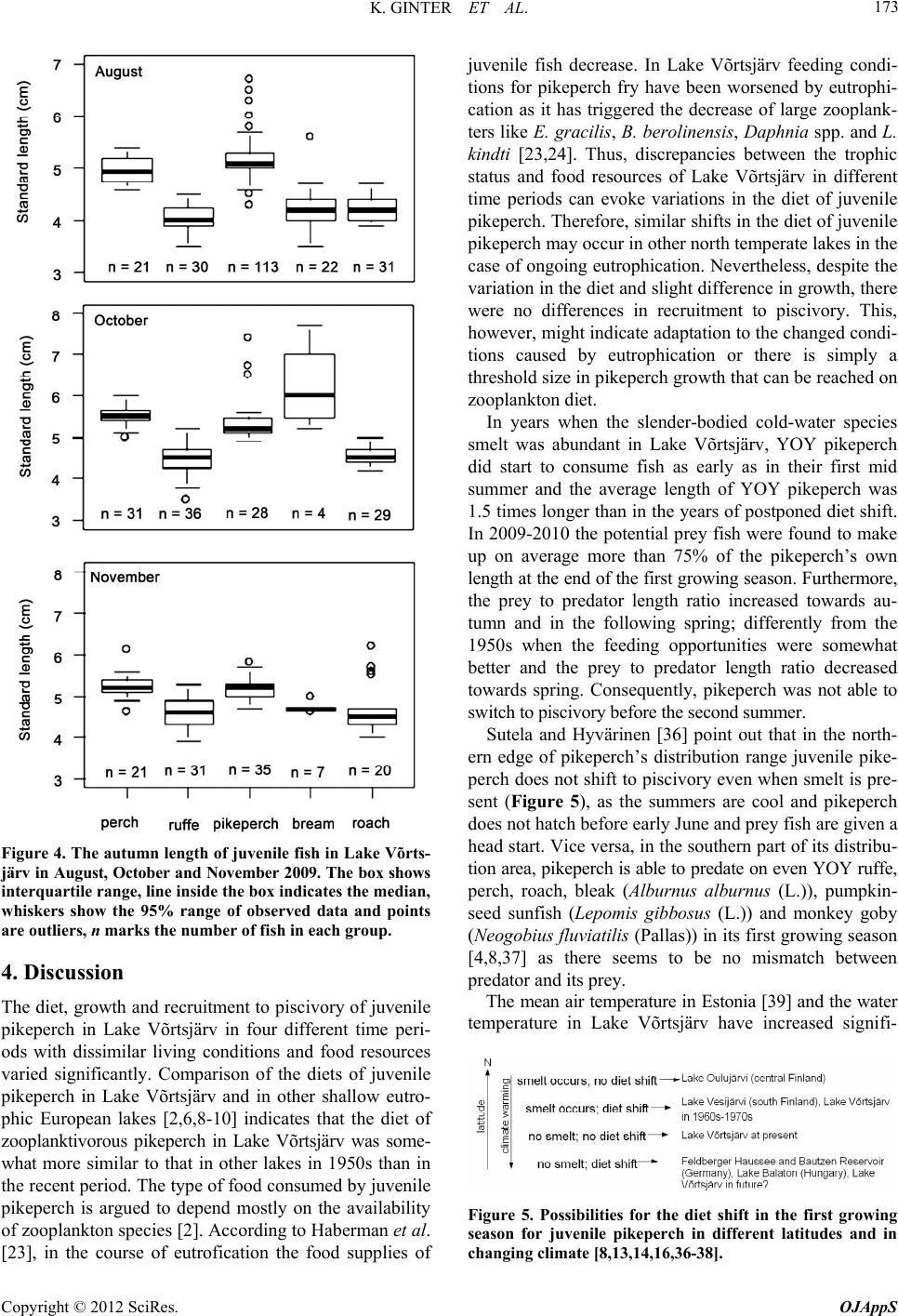 K. GINTER ET AL. 173 Figure 4. The autumn length of juvenile fish in Lake Võrts- järv in August, October and No vember 2009. The box shows interquartile range, line inside the box indicates the median, whiskers show the 95% range of observed data and points are outliers, n marks the number of fish in each group. 4. Discussion The diet, growth and recruitment to piscivory of juvenile pikeperch in Lake Võrtsjärv in four different time peri- ods with dissimilar living conditions and food resources varied significantly. Comparison of the diets of juvenile pikeperch in Lake Võrtsjärv and in other shallow eutro- phic European lakes [2,6,8-10] indicates that the diet of zooplanktivorous pikeperch in Lake Võrtsjärv was some- what more similar to that in other lakes in 1950s than in the recent period. The type of food consumed by juvenile pikeperch is argued to depend mostly on the availability of zooplankton species [2]. According to Haberman et al. [23], in the course of eutrofication the food supplies of juvenile fish decrease. In Lake Võrtsjärv feeding condi- tions for pikeperch fry have been worsened by eutrophi- cation as it has triggered the decrease of large zooplank- ters like E. gracilis, B. berolinensis, Daphnia spp. and L. kindti [23,24]. Thus, discrepancies between the trophic status and food resources of Lake Võrtsjärv in different time periods can evoke variations in the diet of juvenile pikeperch. Therefore, similar shifts in the diet of juvenile pikeperch may occur in other north temperate lakes in the case of ongoing eutrophication. Nevertheless, despite the variation in the diet and slight difference in growth, there were no differences in recruitment to piscivory. This, however, might indicate adaptation to the changed condi- tions caused by eutrophication or there is simply a threshold size in pikeperch growth that can be reached on zooplankton diet. In years when the slender-bodied cold-water species smelt was abundant in Lake Võrtsjärv, YOY pikeperch did start to consume fish as early as in their first mid summer and the average length of YOY pikeperch was 1.5 times longer than in the years of postponed diet shift. In 2009-2010 the potential prey fish were found to make up on average more than 75% of the pikeperch’s own length at the end of the first growing season. Furthermore, the prey to predator length ratio increased towards au- tumn and in the following spring; differently from the 1950s when the feeding opportunities were somewhat better and the prey to predator length ratio decreased towards spring. Consequently, pikeperch was not able to switch to piscivory before the second summer. Sutela and Hyvärinen [36] point out that in the north- ern edge of pikeperch’s distribution range juvenile pike- perch does not shift to piscivory even when smelt is pre- sent (Figure 5), as the summers are cool and pikeperch does not hatch before early June and prey fish are given a head start. Vice versa, in the southern part of its distribu- tion area, pikeperch is able to predate on even YOY ruffe, perch, roach, bleak (Alburnus alburnus (L.)), pumpkin- seed sunfish (Lepomis gibbosus (L.)) and monkey goby (Neogobius fluviatilis (Pallas)) in its first growing season [4,8,37] as there seems to be no mismatch between predator and its prey. The mean air temperature in Estonia [39] and the water temperature in Lake Võrtsjärv have increased signifi- Figure 5. Possibilities for the diet shift in the first growing season for juvenile pikeperch in different latitudes and in changing climate [8,13,14,16,36-38]. Copyright © 2012 SciRes. OJAppS 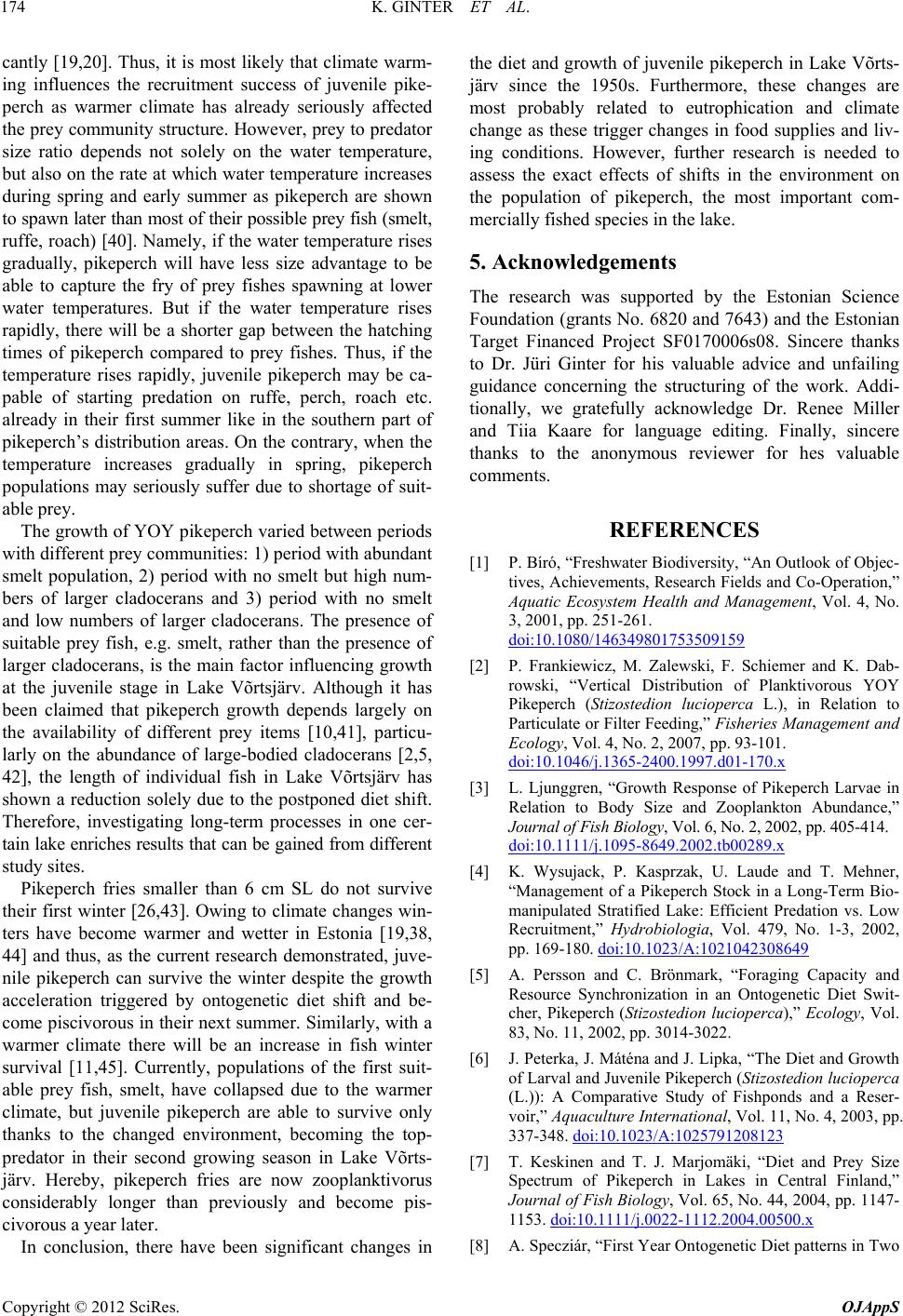 K. GINTER ET AL. 174 cantly [19,20]. Thus, it is most likely that climate warm- ing influences the recruitment success of juvenile pike- perch as warmer climate has already seriously affected the prey community structure. However, prey to predator size ratio depends not solely on the water temperature, but also on the rate at which water temperature increases during spring and early summer as pikeperch are shown to spawn later than most of their possible prey fish (smelt, ruffe, roach) [40]. Namely, if the water temperature rises gradually, pikeperch will have less size advantage to be able to capture the fry of prey fishes spawning at lower water temperatures. But if the water temperature rises rapidly, there will be a shorter gap between the hatching times of pikeperch compared to prey fishes. Thus, if the temperature rises rapidly, juvenile pikeperch may be ca- pable of starting predation on ruffe, perch, roach etc. already in their first summer like in the southern part of pikeperch’s distribution areas. On the contrary, when the temperature increases gradually in spring, pikeperch populations may seriously suffer due to shortage of suit- able prey. The growth of YOY pikeperch varied between periods with different prey communities: 1) period with abundant smelt population, 2) period with no smelt but high num- bers of larger cladocerans and 3) period with no smelt and low numbers of larger cladocerans. The presence of suitable prey fish, e.g. smelt, rather than the presence of larger cladocerans, is the main factor influencing growth at the juvenile stage in Lake Võrtsjärv. Although it has been claimed that pikeperch growth depends largely on the availability of different prey items [10,41], particu- larly on the abundance of large-bodied cladocerans [2,5, 42], the length of individual fish in Lake Võrtsjärv has shown a reduction solely due to the postponed diet shift. Therefore, investigating long-term processes in one cer- tain lake enriches results that can be gained from different study sites. Pikeperch fries smaller than 6 cm SL do not survive their first winter [26,43]. Owing to climate changes win- ters have become warmer and wetter in Estonia [19,38, 44] and thus, as the current research demonstrated, juve- nile pikeperch can survive the winter despite the growth acceleration triggered by ontogenetic diet shift and be- come piscivorous in their next summer. Similarly, with a warmer climate there will be an increase in fish winter survival [11,45]. Currently, populations of the first suit- able prey fish, smelt, have collapsed due to the warmer climate, but juvenile pikeperch are able to survive only thanks to the changed environment, becoming the top- predator in their second growing season in Lake Võrts- järv. Hereby, pikeperch fries are now zooplanktivorus considerably longer than previously and become pis- civorous a year later. In conclusion, there have been significant changes in the diet and growth of juvenile pikeperch in Lake Võrts- järv since the 1950s. Furthermore, these changes are most probably related to eutrophication and climate change as these trigger changes in food supplies and liv- ing conditions. However, further research is needed to assess the exact effects of shifts in the environment on the population of pikeperch, the most important com- mercially fished species in the lake. 5. Acknowledgements The research was supported by the Estonian Science Foundation (grants No. 6820 and 7643) and the Estonian Target Financed Project SF0170006s08. Sincere thanks to Dr. Jüri Ginter for his valuable advice and unfailing guidance concerning the structuring of the work. Addi- tionally, we gratefully acknowledge Dr. Renee Miller and Tiia Kaare for language editing. Finally, sincere thanks to the anonymous reviewer for hes valuable comments. REFERENCES [1] P. Bírό, “Freshwater Biodiversity, “An Outlook of Objec- tives, Achievements, Research Fields and Co-Operation,” Aquatic Ecosystem Health and Management, Vol. 4, No. 3, 2001, pp. 251-261. doi:10.1080/146349801753509159 [2] P. Frankiewicz, M. Zalewski, F. Schiemer and K. Dab- rowski, “Vertical Distribution of Planktivorous YOY Pikeperch (Stizostedion lucioperca L.), in Relation to Particulate or Filter Feeding,” Fisheries Management and Ecology, Vol. 4, No. 2, 2007, pp. 93-101. doi:10.1046/j.1365-2400.1997.d01-170.x [3] L. Ljunggren, “Growth Response of Pikeperch Larvae in Relation to Body Size and Zooplankton Abundance,” Journal of Fish Biology, Vol. 6, No. 2, 2002, pp. 405-414. doi:10.1111/j.1095-8649.2002.tb00289.x [4] K. Wysujack, P. Kasprzak, U. Laude and T. Mehner, “Management of a Pikeperch Stock in a Long-Term Bio- manipulated Stratified Lake: Efficient Predation vs. Low Recruitment,” Hydrobiologia, Vol. 479, No. 1-3, 2002, pp. 169-180. doi:10.1023/A:1021042308649 [5] A. Persson and C. Brönmark, “Foraging Capacity and Resource Synchronization in an Ontogenetic Diet Swit- cher, Pikeperch (Stizostedion lucioperca),” Ecology, Vol. 83, No. 11, 2002, pp. 3014-3022. [6] J. Peterka, J. Máténa and J. Lipka, “The Diet and Growth of Larval and Juvenile Pikeperch (Stizostedion lucioperca (L.)): A Comparative Study of Fishponds and a Reser- voir,” Aquaculture International, Vol. 11, No. 4, 2003, pp. 337-348. doi:10.1023/A:1025791208123 [7] T. Keskinen and T. J. Marjomäki, “Diet and Prey Size Spectrum of Pikeperch in Lakes in Central Finland,” Journal of Fish Biology, Vol. 65, No. 44, 2004, pp. 1147- 1153. doi:10.1111/j.0022-1112.2004.00500.x [8] A. Specziár, “First Year Ontogenetic Diet patterns in Two Copyright © 2012 SciRes. OJAppS 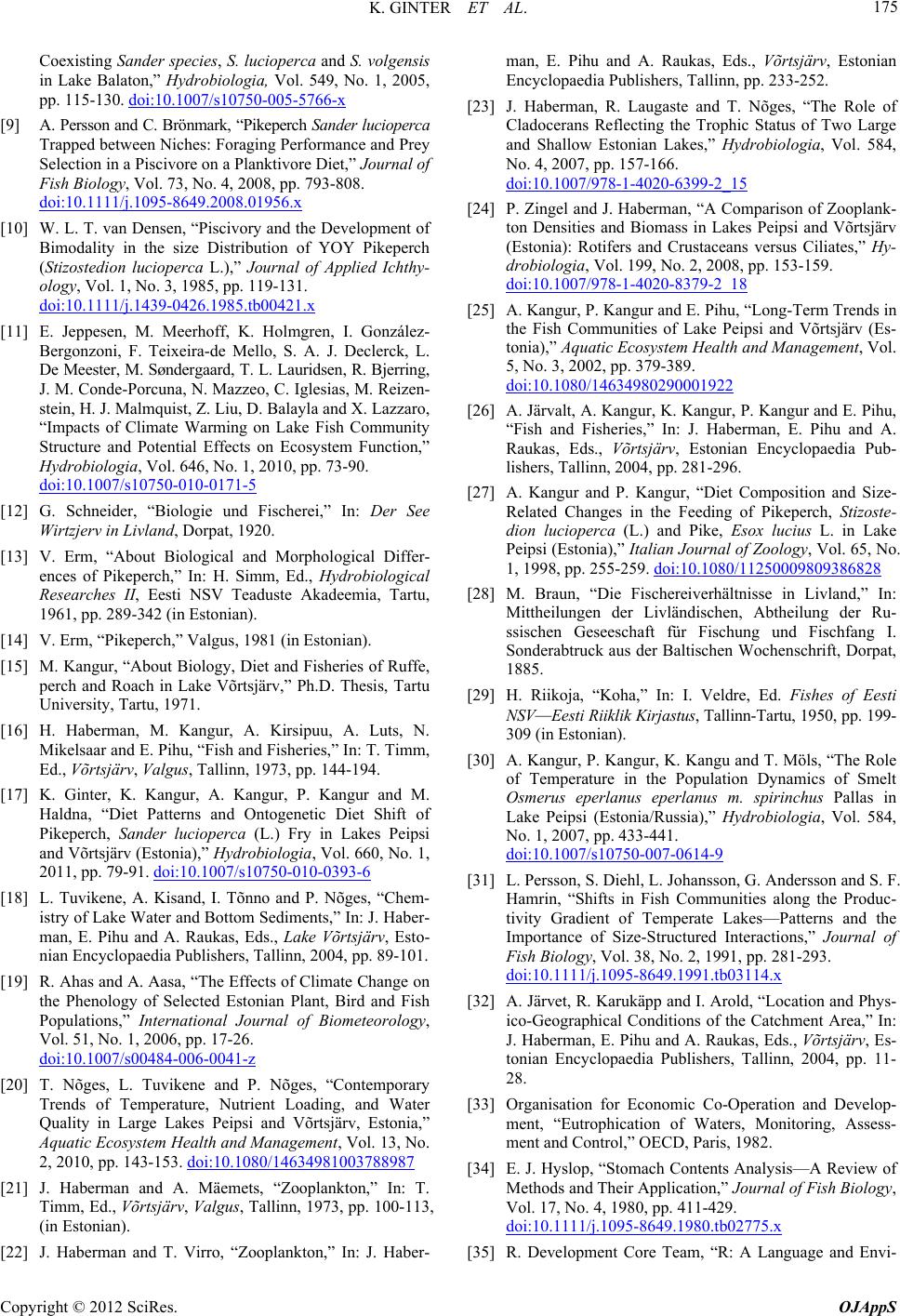 K. GINTER ET AL. 175 Coexisting Sander species, S. lucioperca and S. volgensis in Lake Balaton,” Hydrobiologia, Vol. 549, No. 1, 2005, pp. 115-130. doi:10.1007/s10750-005-5766-x [9] A. Persson and C. Brönmark, “Pikeperch Sander lucioperca Trapped between Niches: Foraging Performance and Prey Selection in a Piscivore on a Planktivore Diet,” Journal of Fish Biology, Vol. 73, No. 4, 2008, pp. 793-808. doi:10.1111/j.1095-8649.2008.01956.x [10] W. L. T. van Densen, “Piscivory and the Development of Bimodality in the size Distribution of YOY Pikeperch (Stizostedion lucioperca L.),” Journal of Applied Ichthy- ology, Vol. 1, No. 3, 1985, pp. 119-131. doi:10.1111/j.1439-0426.1985.tb00421.x [11] E. Jeppesen, M. Meerhoff, K. Holmgren, I. González- Bergonzoni, F. Teixeira-de Mello, S. A. J. Declerck, L. De Meester, M. Søndergaard, T. L. Lauridsen, R. Bjerring, J. M. Conde-Porcuna, N. Mazzeo, C. Iglesias, M. Reizen- stein, H. J. Malmquist, Z. Liu, D. Balayla and X. Lazzaro, “Impacts of Climate Warming on Lake Fish Community Structure and Potential Effects on Ecosystem Function,” Hydrobiologia, Vol. 646, No. 1, 2010, pp. 73-90. doi:10.1007/s10750-010-0171-5 [12] G. Schneider, “Biologie und Fischerei,” In: Der See Wirtzjerv in Livland, Dorpat, 1920. [13] V. Erm, “About Biological and Morphological Differ- ences of Pikeperch,” In: H. Simm, Ed., Hydrobiological Researches II, Eesti NSV Teaduste Akadeemia, Tartu, 1961, pp. 289-342 (in Estonian). [14] V. Erm, “Pikeperch,” Valgus, 1981 (in Estonian). [15] M. Kangur, “About Biology, Diet and Fisheries of Ruffe, perch and Roach in Lake Võrtsjärv,” Ph.D. Thesis, Tartu University, Tartu, 1971. [16] H. Haberman, M. Kangur, A. Kirsipuu, A. Luts, N. Mikelsaar and E. Pihu, “Fish and Fisheries,” In: T. Timm, Ed., Võrtsjärv, Valgus, Tallinn, 1973, pp. 144-194. [17] K. Ginter, K. Kangur, A. Kangur, P. Kangur and M. Haldna, “Diet Patterns and Ontogenetic Diet Shift of Pikeperch, Sander lucioperca (L.) Fry in Lakes Peipsi and Võrtsjärv (Estonia),” Hydrobiologia, Vol. 660, No. 1, 2011, pp. 79-91. doi:10.1007/s10750-010-0393-6 [18] L. Tuvikene, A. Kisand, I. Tõnno and P. Nõges, “Chem- istry of Lake Water and Bottom Sediments,” In: J. Haber- man, E. Pihu and A. Raukas, Eds., Lake Võrtsjärv, Esto- nian Encyclopaedia Publishers, Tallinn, 2004, pp. 89-101. [19] R. Ahas and A. Aasa, “The Effects of Climate Change on the Phenology of Selected Estonian Plant, Bird and Fish Populations,” International Journal of Biometeorology, Vol. 51, No. 1, 2006, pp. 17-26. doi:10.1007/s00484-006-0041-z [20] T. Nõges, L. Tuvikene and P. Nõges, “Contemporary Trends of Temperature, Nutrient Loading, and Water Quality in Large Lakes Peipsi and Võrtsjärv, Estonia,” Aquatic Ecosystem Health and Management, Vol. 13, No. 2, 2010, pp. 143-153. doi:10.1080/14634981003788987 [21] J. Haberman and A. Mäemets, “Zooplankton,” In: T. Timm, Ed., Võrtsjärv, Valgus, Tallinn, 1973, pp. 100-113, (in Estonian). [22] J. Haberman and T. Virro, “Zooplankton,” In: J. Haber- man, E. Pihu and A. Raukas, Eds., Võrtsjärv, Estonian Encyclopaedia Publishers, Tallinn, pp. 233-252. [23] J. Haberman, R. Laugaste and T. Nõges, “The Role of Cladocerans Reflecting the Trophic Status of Two Large and Shallow Estonian Lakes,” Hydrobiologia, Vol. 584, No. 4, 2007, pp. 157-166. doi:10.1007/978-1-4020-6399-2_15 [24] P. Zingel and J. Haberman, “A Comparison of Zooplank- ton Densities and Biomass in Lakes Peipsi and Võrtsjärv (Estonia): Rotifers and Crustaceans versus Ciliates,” Hy- drobiologia, Vol. 199, No. 2, 2008, pp. 153-159. doi:10.1007/978-1-4020-8379-2_18 [25] A. Kangur, P. Kangur and E. Pihu, “Long-Term Trends in the Fish Communities of Lake Peipsi and Võrtsjärv (Es- tonia),” Aquatic Ecosystem Health and Management, Vol. 5, No. 3, 2002, pp. 379-389. doi:10.1080/14634980290001922 [26] A. Järvalt, A. Kangur, K. Kangur, P. Kangur and E. Pihu, “Fish and Fisheries,” In: J. Haberman, E. Pihu and A. Raukas, Eds., Võrtsjärv, Estonian Encyclopaedia Pub- lishers, Tallinn, 2004, pp. 281-296. [27] A. Kangur and P. Kangur, “Diet Composition and Size- Related Changes in the Feeding of Pikeperch, Stizoste- dion lucioperca (L.) and Pike, Esox lucius L. in Lake Peipsi (Estonia),” Italian Journal of Zoology, Vol. 65, No. 1, 1998, pp. 255-259. doi:10.1080/11250009809386828 [28] M. Braun, “Die Fischereiverhältnisse in Livland,” In: Mittheilungen der Livländischen, Abtheilung der Ru- ssischen Geseeschaft für Fischung und Fischfang I. Sonderabtruck aus der Baltischen Wochenschrift, Dorpat, 1885. [29] H. Riikoja, “Koha,” In: I. Veldre, Ed. Fishes of Eesti NSV—Eesti Riiklik Kirjastus, Tallinn-Tartu, 1950, pp. 199- 309 (in Estonian). [30] A. Kangur, P. Kangur, K. Kangu and T. Möls, “The Role of Temperature in the Population Dynamics of Smelt Osmerus eperlanus eperlanus m. spirinchus Pallas in Lake Peipsi (Estonia/Russia),” Hydrobiologia, Vol. 584, No. 1, 2007, pp. 433-441. doi:10.1007/s10750-007-0614-9 [31] L. Persson, S. Diehl, L. Johansson, G. Andersson and S. F. Hamrin, “Shifts in Fish Communities along the Produc- tivity Gradient of Temperate Lakes—Patterns and the Importance of Size-Structured Interactions,” Journal of Fish Biology, Vol. 38, No. 2, 1991, pp. 281-293. doi:10.1111/j.1095-8649.1991.tb03114.x [32] A. Järvet, R. Karukäpp and I. Arold, “Location and Phys- ico-Geographical Conditions of the Catchment Area,” In: J. Haberman, E. Pihu and A. Raukas, Eds., Võrtsjärv, Es- tonian Encyclopaedia Publishers, Tallinn, 2004, pp. 11- 28. [33] Organisation for Economic Co-Operation and Develop- ment, “Eutrophication of Waters, Monitoring, Assess- ment and Control,” OECD, Paris, 1982. [34] E. J. Hyslop, “Stomach Contents Analysis—A Review of Methods and Their Application,” Journal of Fish Biology, Vol. 17, No. 4, 1980, pp. 411-429. doi:10.1111/j.1095-8649.1980.tb02775.x [35] R. Development Core Team, “R: A Language and Envi- Copyright © 2012 SciRes. OJAppS 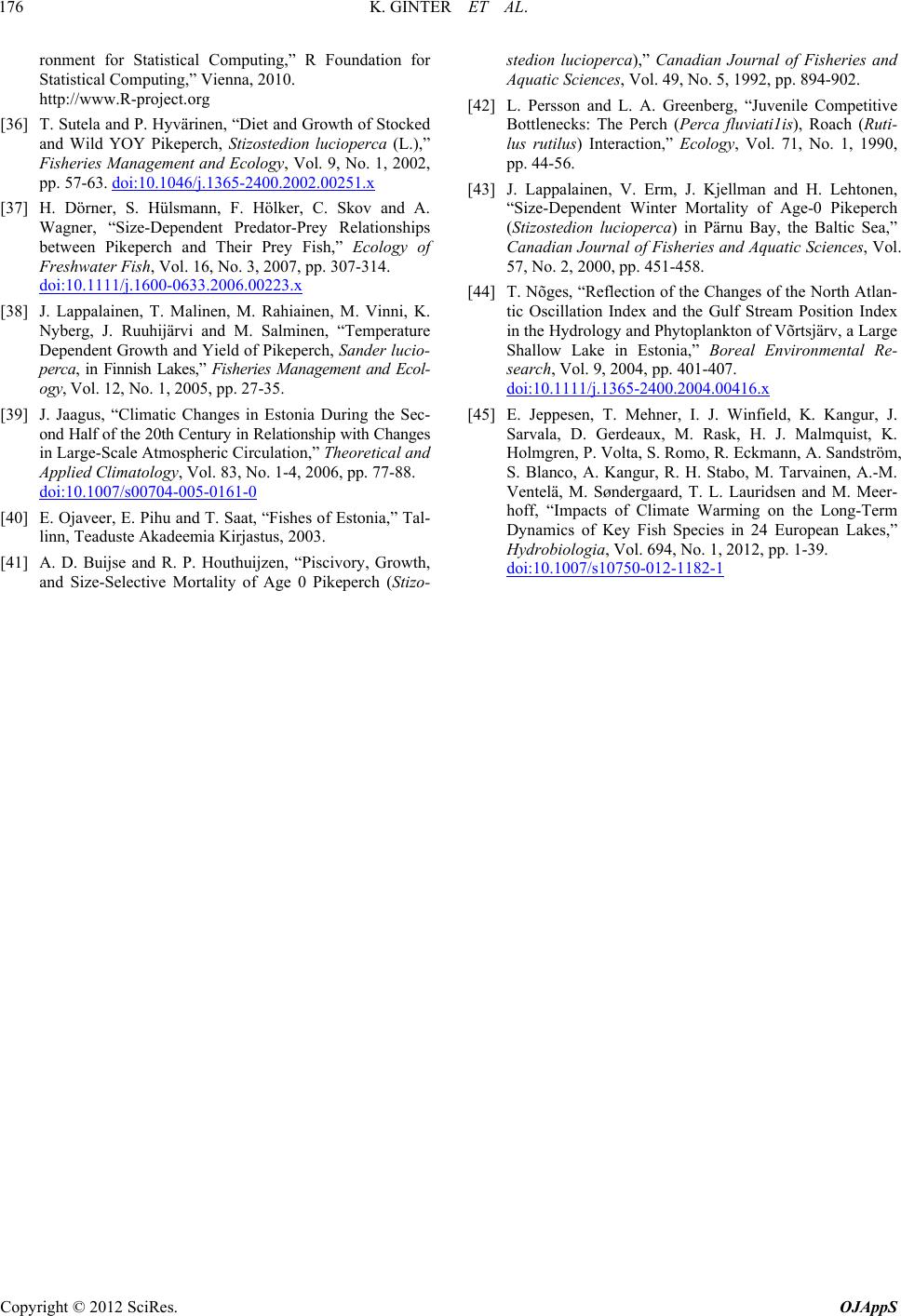 K. GINTER ET AL. Copyright © 2012 SciRes. OJAppS 176 ronment for Statistical Computing,” R Foundation for Statistical Computing,” Vienna, 2010. http://www.R-project.org [36] T. Sutela and P. Hyvärinen, “Diet and Growth of Stocked and Wild YOY Pikeperch, Stizostedion lucioperca (L.),” Fisheries Management and Ecology, Vol. 9, No. 1, 2002, pp. 57-63. doi:10.1046/j.1365-2400.2002.00251.x [37] H. Dörner, S. Hülsmann, F. Hölker, C. Skov and A. Wagner, “Size-Dependent Predator-Prey Relationships between Pikeperch and Their Prey Fish,” Ecology of Freshwater Fish, Vol. 16, No. 3, 2007, pp. 307-314. doi:10.1111/j.1600-0633.2006.00223.x [38] J. Lappalainen, T. Malinen, M. Rahiainen, M. Vinni, K. Nyberg, J. Ruuhijärvi and M. Salminen, “Temperature Dependent Growth and Yield of Pikeperch, Sander lucio- perca, in Finnish Lakes,” Fisheries Management and Ecol- ogy, Vol. 12, No. 1, 2005, pp. 27-35. [39] J. Jaagus, “Climatic Changes in Estonia During the Sec- ond Half of the 20th Century in Relationship with Changes in Large-Scale Atmospheric Circulation,” Theoretical and Applied Climatology, Vol. 83, No. 1-4, 2006, pp. 77-88. doi:10.1007/s00704-005-0161-0 [40] E. Ojaveer, E. Pihu and T. Saat, “Fishes of Estonia,” Tal- linn, Teaduste Akadeemia Kirjastus, 2003. [41] A. D. Buijse and R. P. Houthuijzen, “Piscivory, Growth, and Size-Selective Mortality of Age 0 Pikeperch (Stizo- stedion lucioperca),” Canadian Journal of Fisheries and Aquatic Sciences, Vol. 49, No. 5, 1992, pp. 894-902. [42] L. Persson and L. A. Greenberg, “Juvenile Competitive Bottlenecks: The Perch (Perca fluviati1is), Roach (Ruti- lus rutilus) Interaction,” Ecology, Vol. 71, No. 1, 1990, pp. 44-56. [43] J. Lappalainen, V. Erm, J. Kjellman and H. Lehtonen, “Size-Dependent Winter Mortality of Age-0 Pikeperch (Stizostedion lucioperca) in Pärnu Bay, the Baltic Sea,” Canadian Journal of Fisheries and Aquatic Sciences, Vol. 57, No. 2, 2000, pp. 451-458. [44] T. Nõges, “Reflection of the Changes of the North Atlan- tic Oscillation Index and the Gulf Stream Position Index in the Hydrology and Phytoplankton of Võrtsjärv, a Large Shallow Lake in Estonia,” Boreal Environmental Re- search, Vol. 9, 2004, pp. 401-407. doi:10.1111/j.1365-2400.2004.00416.x [45] E. Jeppesen, T. Mehner, I. J. Winfield, K. Kangur, J. Sarvala, D. Gerdeaux, M. Rask, H. J. Malmquist, K. Holmgren, P. Volta, S. Romo, R. Eckmann, A. Sandström, S. Blanco, A. Kangur, R. H. Stabo, M. Tarvainen, A.-M. Ventelä, M. Søndergaard, T. L. Lauridsen and M. Meer- hoff, “Impacts of Climate Warming on the Long-Term Dynamics of Key Fish Species in 24 European Lakes,” Hydrobiologia, Vol. 694, No. 1, 2012, pp. 1-39. doi:10.1007/s10750-012-1182-1 |

